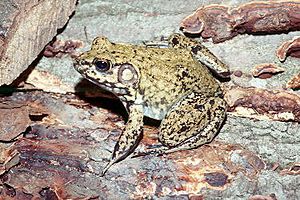River frog facts for kids
Quick facts for kids River frog |
|
|---|---|
 |
|
| Conservation status | |
| Scientific classification | |
| Synonyms | |
|
Rana heckscheri Wright, 1924 |
The river frog (Lithobates heckscheri) is a type of frog that lives in water. It belongs to the Ranidae family. These frogs are found only in the southeastern United States. They live in places like rivers, swamps, and lakes. Sadly, their homes are sometimes destroyed, which is a problem for them.
Contents
About the River Frog
The river frog is a big frog. Adult frogs are usually between 7 and 13 centimeters (about 3 to 5 inches) long. Their skin feels rough and wrinkly. Unlike some other frogs, they don't have ridges along their backs.
Their back is usually a dark green or blackish-green color. Their belly is dark grey or black, with light, wavy lines and spots. A special thing about them is the white spots on their lips, especially the bottom one. This helps tell them apart from other frogs like bullfrogs and pig frogs. They also have a light band around their groin area.
Male river frogs have a yellowish throat. Their eardrums (called tympani) are bigger than their eyes. Female frogs have eardrums that are smaller than their eyes.
Where River Frogs Live
River frogs live along the coasts of the southeastern United States. You can find them from southern North Carolina down to southeastern Mississippi and northern Florida. They like wet places with plants growing in the water, near streams, rivers, ponds, and lakes.
River Frog Life and Habits
River frogs are mostly active at night. They eat insects and other small creatures. They also eat small animals, including other frogs. They spend a lot of time in the water and are not very shy.
When it's hot, they stay in wet places to keep cool. If the temperature drops below about 17°C (63°F), they hide underwater to stay warm.
Reproduction and Life Cycle
River frogs breed between April and August. The males make a deep, low, snoring sound to attract females. They call from the edges of ponds and swamps.
The female lays thousands of eggs in a floating layer among the plants in the water. These eggs hatch in about three days. The baby frogs, called tadpoles, are dark at first. They become lighter as they grow, but their tail fin has a dark edge.
Tadpoles gather in shallow water during the day, sometimes in large groups. At night, they move into deeper water. They eat both plants and small animals. River frog tadpoles stay as tadpoles for a long time, sometimes over a year. They can grow to be very large, over 97 millimeters (almost 4 inches) long.
After they change into frogs (this is called metamorphosis), the young frogs are about 30 to 52 millimeters (1 to 2 inches) long. They then move away from the water's edge. Many young frogs don't survive, as there are many more young frogs than adult frogs.
Who Eats River Frogs?
Many animals like to eat river frog tadpoles and young frogs. These include banded water snakes, other water snakes, largemouth bass fish, and grackle birds.
However, river frogs might have something in their skin that tastes bad or smells unpleasant. Some snakes, like the indigo snake, have been seen gagging and even throwing up after trying to eat a river frog. The snake would then wipe its mouth on the ground, showing how much it disliked the taste!
Conservation Status
The river frog lives in a large area and is quite common in many places. There seem to be many of them, and their numbers are stable. The biggest danger to them is when their homes are damaged or destroyed.
However, river frogs live in several protected areas. Because of this, the IUCN says that the river frog is of "least concern" for now. This means they are not currently in danger of disappearing.
See also
 In Spanish: Lithobates heckscheri para niños
In Spanish: Lithobates heckscheri para niños
Images for kids



